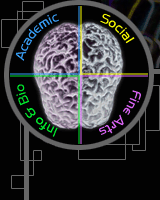

Ever since I was little, I've looked into my dreams when I'm in need of
a little guidance or help. I believe dreams are the "inner/younger self"
(Which does not know how to communicate by language or the written word)
trying to communicate with the "outer self". I love to analysis my dreams,
and I keep my own dream diary. I've found many answers or suggestions to
problems I faced over the years in my dreams. Sometimes, dreaming can also
be a means of escape. When everything in the external world is stressing
me out, I'll just escape to my internal world, until I feel that my strength
and energy are refueled. Using relationships, symbols, associations and
situations, dreams paint pictures and draw story boards. I wrote my senior
thesis on dreams, and have excerpted it here (leaving out the two novels
I analyzed).
As any dream expert will tell you, the first step in translating and interpreting your dreams is understanding the symbols they are made up of. The work of Sigmund Freud, Carl Jung, and Medard Boss form the three main currents of the psychodynamic understanding of dreams, and every contemporary method of interpretation uses some combination and development of the ideas and practices of these European psychiatrists. Freud believed that the dream was a distortion of repressed wishes, "Dreams have proved that what is suppressed continues to exist in normal people as well as abnormal, and remains capable of psychical functioning. Dreams themselves are among manifestations of this suppressed material…" (Freud 647) In earlier ages, it was taken for granted that dreams could bring messages or warnings to an individual pertaining to events that were actually happening or about to happen in the external world. "Dreams may provide us with very valuable information about the external world… These may act as reminders, warnings, or even predictions to the individual dreamer…" (Faraday 160)
Another theory of dream implication that was brought about by Carl Jung, is projection. The dreamer dreams subjectively, highlighting characteristics that the dreamer shares with their dream image. Carl Jung wrote: "The dream describes one's inner situation, but the conscious mind denies its truth and reality, or admits it only symbolically… It [dreams] shows the inner truth and reality of the dreamer as they really are…" (Jung, 35) This 'new' process of interpretation has been integrated into modern dream analysis in contrast to Freud's objective or representative methods.
There are still many other methods of dream analysis. Medard Boss suggests, the dreaming state is, with few exception, characterized by a mode of being that is concrete, anchored to the present, much less perceptive, and rather narrow compared to the waking state.
"Boss sees dreaming as a concrete mode of experience, almost always devoid of mental abstraction and insight; he denies that dream images are metaphoric abstractions… Rather, he believed that… a patient could be led in the waking state to grasp the relationships of significances perceived in dreaming to analogous ones in waking…"(Delaney 81)
Whatever system you wish to accredit more, all methods of dream interpretation combined and applied together may aid in a better understanding of our own inner desires, needs, tribulations, and uncertainties.
In forming a bridge between mind and body, dreams may be used as a springboard from which we can leap to new realms of consciousness and enlarge our vision not only of ourselves, but also of the universe in which we live (Faraday 35)Understanding the complex shapes that dreams can take on will often enlighten us to aspects of ourselves that we were not aware of. Through the works of Carl Jung, Sigmund Freud, Ann Faraday, Gayle Delaney, and the novels of Jim Grimsley and Richard LaPlante, it is clearly evident, that no matter what technique you choose, there is a direct correlation between the significance of dreams, and one's waking life.



